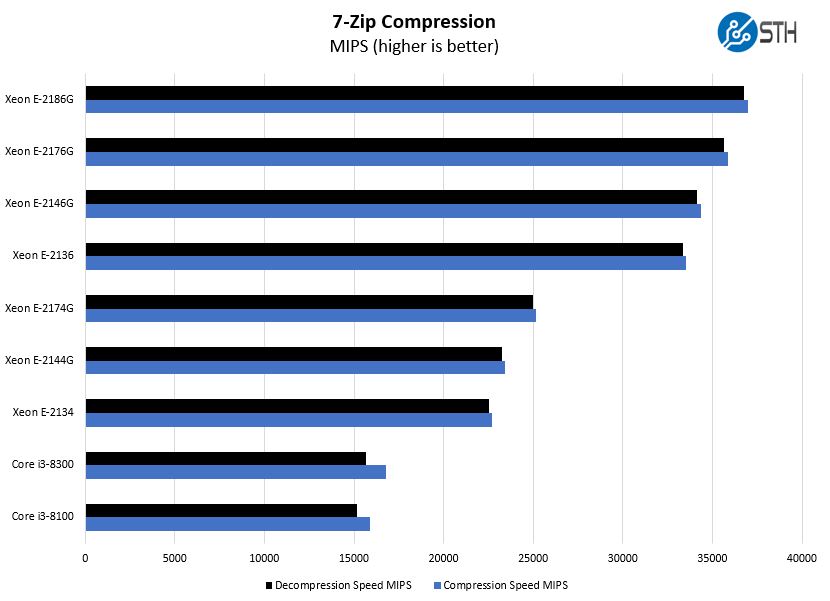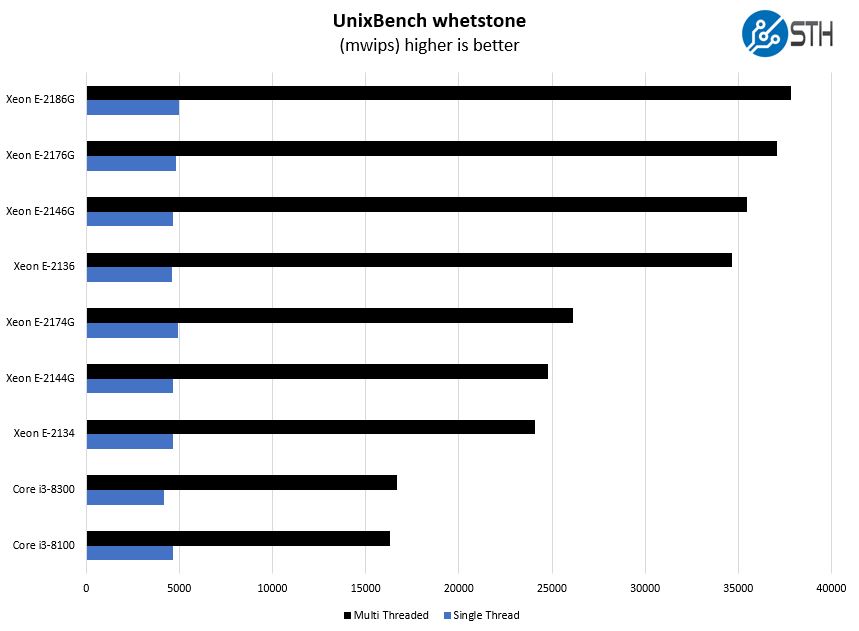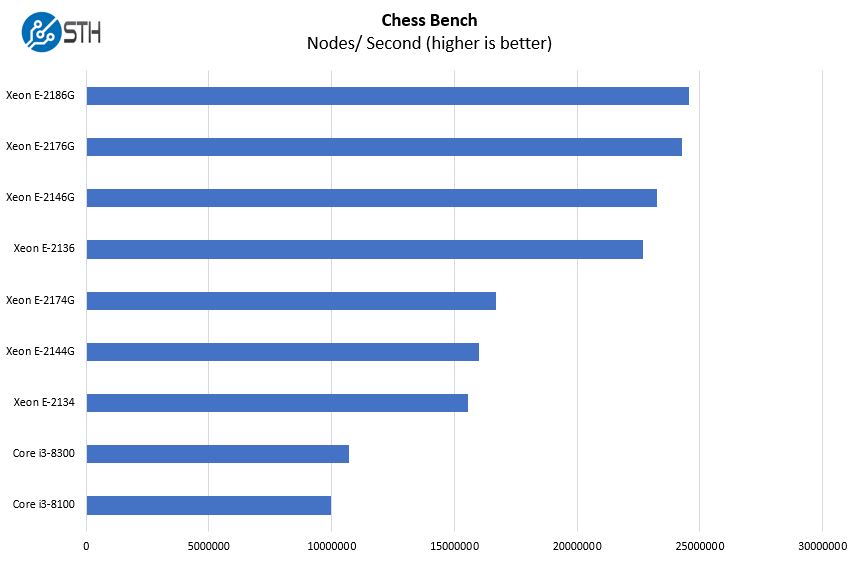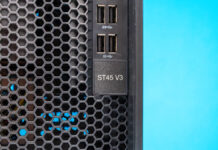Dell EMC PowerEdge T140 Compute Performance
For this exercise, we are using our legacy Linux-Bench scripts which help us see cross-platform “least common denominator” results we have been using for years as well as several results from our updated Linux-Bench2 scripts. At this point, our benchmarking sessions take days to run and we are generating well over a thousand data points. We are also running workloads for software companies that want to see how their software works on the latest hardware. As a result, this is a small sample of the data we are collecting and can share publicly. Our position is always that we are happy to provide some free data but we also have services to let companies run their own workloads in our lab, such as with our DemoEval service. What we do provide is an extremely controlled environment where we know every step is exactly the same and each run is done in a real-world data center, not a test bench.
We are going to show off a few results, and highlight a number of interesting data points in this article.
Python Linux 4.4.2 Kernel Compile Benchmark
This is one of the most requested benchmarks for STH over the past few years. The task was simple, we have a standard configuration file, the Linux 4.4.2 kernel from kernel.org, and make the standard auto-generated configuration utilizing every thread in the system. We are expressing results in terms of compiles per hour to make the results easier to read:

Key here is that the big performance value driver is the core count and thread count. That produces a step function of performance.
c-ray 1.1 Performance
We have been using c-ray for our performance testing for years now. It is a ray tracing benchmark that is extremely popular to show differences in processors under multi-threaded workloads. We are going to use our 8K results which work well at this end of the performance spectrum.

If you are looking for a low cost 1-4 hard drive storage system, the Intel Core i3-8100 is a great pick.
7-zip Compression Performance
7-zip is a widely used compression/ decompression program that works cross-platform. We started using the program during our early days with Windows testing. It is now part of Linux-Bench.

Compression is a major performance component in the class of systems like the Dell EMC PowerEdge T140. Here the more cores, threads, and higher clock speeds you have, the better compression scales.
Sysbench CPU test
Sysbench is another one of those widely used Linux benchmarks. We specifically are using the CPU test, not the OLTP test that we use for some storage testing.

While we are showing differences between SKUs in terms of CPU performance, another aspect includes integrated GPUs. Both Intel Xeon E-21xxG parts and the Intel Core i3-8000 series parts have integrated GPUs.
OpenSSL Performance
OpenSSL is widely used to secure communications between servers. This is an important protocol in many server stacks. We first look at our sign tests:

Here are the verify results:

OpenSSL is a foundational technology for the web and many servers like the Dell EMC PowerEdge T140 will act as local web application servers. If you were to compare the Intel Xeon E-2136 to the Xeon E-2174G the former is less expensive but considerably faster due to having more cores. The Intel naming conventions are not necessarily in numerical performance order.
UnixBench Dhrystone 2 and Whetstone Benchmarks
Some of the longest-running tests at STH are the venerable UnixBench 5.1.3 Dhrystone 2 and Whetstone results. They are certainly aging, however, we constantly get requests for them, and many angry notes when we leave them out. UnixBench is widely used so we are including it in this data set. Here are the Dhrystone 2 results:

Here are the whetstone results:

Single threaded performance on all of these parts is significantly better than some of the lower power options. If you look at the AMD Opteron X3421 powered HPE ProLiant MicroServer Gen10, for example, the inexpensive CPU options in the Dell EMC PowerEdge T140 handily beat that solution.
Chess Benchmarking
Chess is an interesting use case since it has almost unlimited complexity. Over the years, we have received a number of requests to bring back chess benchmarking. We have been profiling systems and are ready to start sharing results:

Each frequency step up on different SKUs is accompanied by increased performance. We urge our readers to take the performance data we have and compare it to the incremental pricing in the configurator to make their purchasing decision.
Next, we are going to look at the Dell EMC PowerEdge T140 power consumption before finishing off with the STH Server Spider, and our final words.




Hello,
How about hdd cooling fans ? Had temperature issues with 4 hdd’s in my T20. Had to switch to another case.
How many SATA connectors are there? The case/mobo looks like poweredge T110 II which we really like at our Uni. Unlike this one, in the T110 II the front 5.25 bays could be replaced by 3 or 4 hdd for ZFS mirrors (pool) by adding a small PCI-E sata card. I do hope that the PCI-E lanes support some basic gfx card (at least a nvidia Geforce GT1030) to get remote “ssh -X” for some virtualisation software. (PE T110 II has tons of issues with any gfx card as there is a kind of < 20W limit).
When the third image in a server review is a latch, you know you’re reading one of STH’s crazy in depth reviews. Nothing says hands on like featuring a part meant to put a hand on.
Any word on whether an inexpensive StarTech M.2 adapter can be used to accommodate a Samsung 983 DCT (MZ-1LB960NE) M.2 NVMe drive and have the T140 boot from it? I think Dell removed such NVMe boot ability from the T30.
Recently built a T140 for a client needing a bare metal SQL box with some solid per core grunt and the Xeon E’s are top of the class in that dept. Basically the T140 is a single socket Xeon workstation with iDRAC bolted on. That’s fine, because there’s always been a server line in that class and they’ve always been good value. I went with Intel SSDs in RAID 1, but with the BOSS card the server can do Intel VROC, which is NVMe RAID native….at least according to Dell.
Is there any advantage in having a Xeon E-xxxxG processor on that machine? Will the graphics capabilities of the chip be used for anything, or is there any wiring to make it available?
Hi Paulo – not for display output, however, you can use features like Quick Sync
I bought myself one, it’s really nice.
One thing that annoys me though is that the E-2136 I bought it with is capped for some reason at 4.18 GHz instead of going all the way up to 4.5 as it should have. And it doesn’t hit the 80W while testing single thread so it doesn’t throttle. I’m testing all this with intel extreme tuning utility to get the whole picture.
Dell capped it for some reason.
Actually the limit is exactly 4.2 under Linux, under Windows I only got to 4.18, but under linux, running cooler (70C) + undervolting and on a half an hour compiling it stays at 4.199 or 4.2 GHZ, never passing that, even by 1 Mhz, which is annoying as nowhere is written that you’re limited by Dell.
Preciso colocar mais HD SATA, ja usei uma CADDY HD/DVD e coloquei um SSD. porem tenho mais um disco SATA 1TB para adicionar além dos 4 existente.
qual a sugestao?
Hello
I just got the T140 with Intel 2126G (80 W), H330 controller and 1x 1 TB HDD.
My config should consume less power than the one you tested, since your config includes the Intel 2128G rated for 95 W
My power meter says:
220 V \ 50 Hz
51 W
Power factor 0.87
0.26 A
Why you have just 35 W when idle?
Hello, we just got one T140 with 2126G, 1TB HDD and 8GB DDR4 ECC for a client. Working upgrade:
3x8GB Samsung DDR4-2666 CL19 ECC (M391A1K43BB2-CTD -> 32GB)
Gigabyte Nvidia GT 1030 Low Profile 2G (GV-N1030D5-2GL, integrated video disabled)
Samsung 860 Pro 1TB SATA SSD (HDD for backup)
Will be used as an entry server-workstation with dualdisplay.
With iDRAC9, is an additional license required to get remote desktop capabilities, like with iLO?
Licenses are needed to get Idrac9 on a T140 to show the console display. I had to buy a vga-to-hdmi adapter to get a view of the console, for installation. A little disappointing for a server. Noise-level is low, but too much for a living-room.
Hello;
I am in between to choose this one for HPE ML30 Gen10. Which one would you choose and why?
Regarding CPU Turbo issue:
I’d guess its a deliberate BIOS limit on this board, any E-series Xeon i’ve seen is running max at its all-core Turbo frequency.
A comment above says that iDRAC9 as included with the T140 does not include a remote console feature. Is there an upgrade or license that adds that? And if so, does it ruin the economics of the server as is the case with the ProLiant servers that are a notch above the MicroServer Gen10 Plus?
Configured one of these for various test loads and have few comments. First of all it indeed does not support NVMe boot which is a bit odd for 2019s machine, not a real problem since I can always use a boot loader from USB to continue booting from NVMe.
The option to use Dell BOSS card also means you are limited to the two older SSD models BOSS supports and the card itself is just few bulk components for hefty price. Obviously if you already have a fleet of Dells and can acquire these things cheaply it’s a different situation and it also enables things in IDRAC and so on.
Also while the machine has multiple PCIE slots it considers most of the cards “third party devices” and automatically ramps up fans up to painful levels. Now there is a switch that can be used ignore “3rd party device fan control” via racadm. But for some reason my NVMe wasn’t considered third party PCIE card but a PCIE SSD meaning there was nothing to do. I found out that by downgrading iDRAC to 3.30 you could manually control the fans via undocumented IPMI codes (disgusting) so I tried downgrading. And in the end just installing 3.30 fixed the issue without any manual tuning, fans are set to auto and not running as 100% even with the unholy non-Dell third party PCIE device installed.
The decision to set fans at 100% when encountering “unknown devices” is just stupid. What’s the point of PCIE slots if you are not going to allow standard compliant devices to run easily? Is the case so badly designed that a typical PCIE device power draw could cause issues?
Is it make sense to buy xeon based processor in 2021? As now ARM servers can come soon with less cost better performance? Please suggest what do you think ? Thanks.
I really think this review missed out on a critical limitation in this series of Dell PowerEdge servers. Even though it was/is offered with the G series of E-2100/2200 processors, the use of the graphics engine is disabled. It does not allow the quick sync to be used for hardware transcoding. I found this out the hard way after building a TrueNAS Scale system on this server, upgrading the CPU from a 2124 to a 2126G only to find that it doesn’t work.
Digging back through Dell’s documentation, it says this in the Tech Guide:
“NOTE: We do not support graphics with E-2100 and E-2200 processors, Graphics cannot be enabled on Dell EMC servers using this processor due to technical restrictions.”
What technical restrictions? The chipset supports it, but the BIOS doesn’t have it enabled?